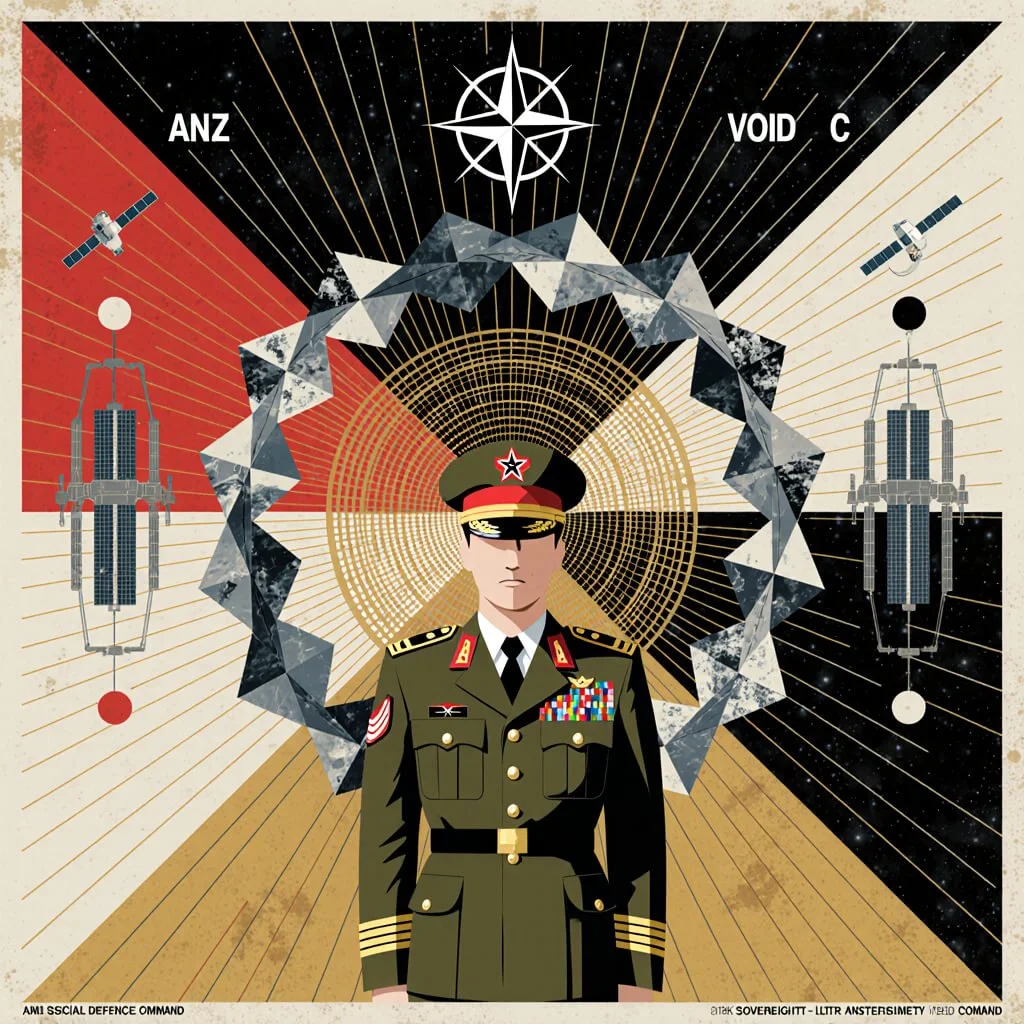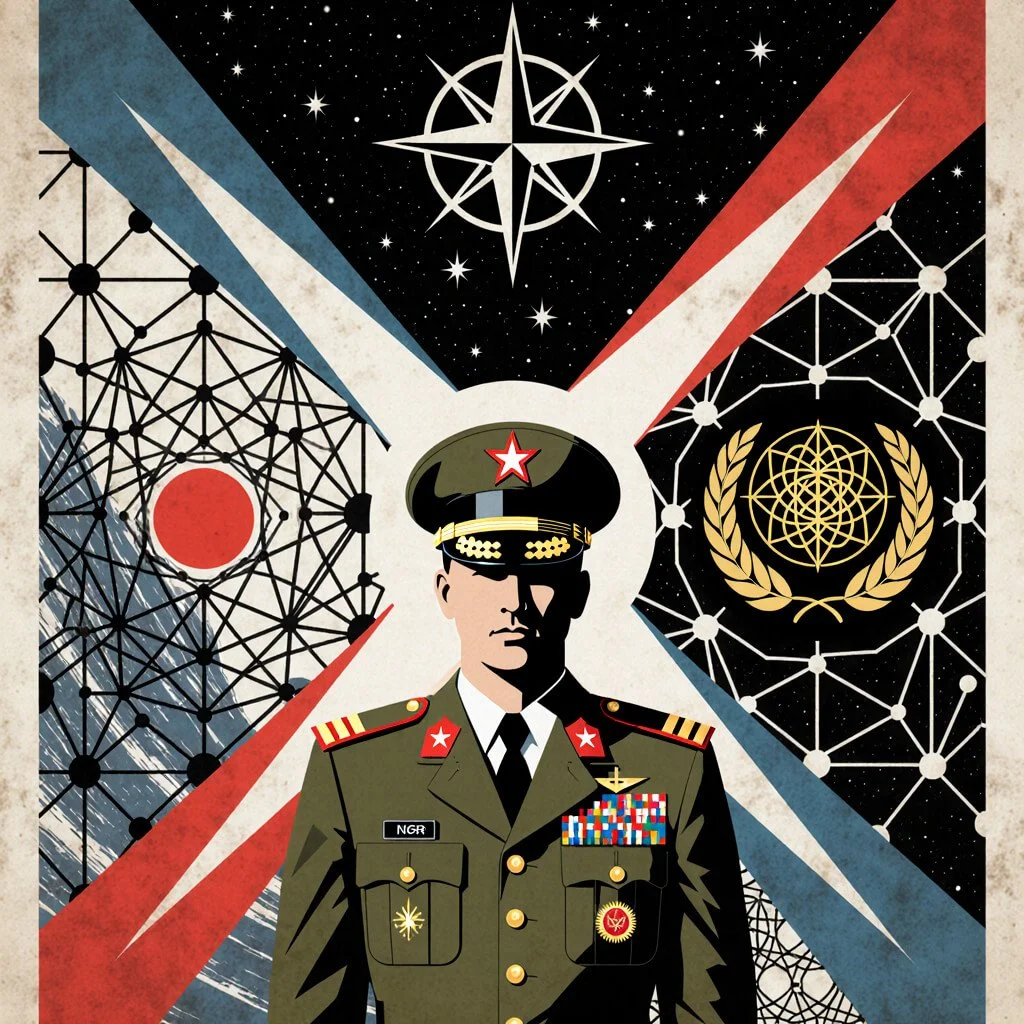Transdimensional Justice: The Thermodynamic Architecture of Lawful Liberation
A Metasynthesis of Compassion Physics, Quantum Martial Ecology, and the Law of Coherent Systems
Transdimensional Justice: The Physics of Lawful Coherence
Abstract
Following the completion of Quantum Martial Ecology: The Great Work of Compassion as Lawful Physics and its companion studies in Holographic Defense Architecture and Spectral-Fractal-Medical: The Compassion Protocol, this white paper advances the formalization of Transdimensional Justice—a framework integrating measurable compassion physics with legal reasoning across biological, social, and cosmic scales.
Through cross-disciplinary metasynthesis spanning thermodynamics, neuroscience, systems law, and civic ethics, we establish compassion as both operator and outcome of lawful liberation.
This work proposes crystalline and fractalline justice models to safeguard consciousness, ecosystems, and simulation economies, providing scientifically grounded architecture for global truth and reconciliation.
Our purpose: to articulate how the physics of empathy becomes the foundation for planetary restoration and sacred civic governance.
Keywords: compassion physics, transdimensional justice, holographic defense, quantum martial ecology, cognitive liberty, thermodynamic jurisprudence, coherence measurement
Executive Summary
Transdimensional Justice: The Thermodynamic Architecture of Lawful Liberation integrates measurable compassion physics with emerging paradigms in law, ethics, and systems governance.
Drawing on the companion research corpus—Quantum Martial Ecology, Spectral–Fractal–Medical: The Compassion Protocol, and Quantum-Enhanced Holographic Defense Architecture—this white paper formalizes a new jurisprudential framework in which coherence, not control, defines the basis of lawful order.
Through cross-disciplinary synthesis of thermodynamics, neuroscience, cybernetics, and civic ethics, the paper demonstrates that compassion functions as a lawful operator capable of reducing entropy across physiological, social, and ecological systems.
Using validated metrics such as the Composite Coherence Index (C), Thermodynamic Justice Index (TJI), and coherence coupling constants (Φ(κ), λ), the framework establishes quantifiable relationships between empathy, governance efficiency, and planetary regeneration.
Institutionally, the implementation roadmap advances three phases:
Physiological Validation — confirming cross-site reliability of coherence metrics in clinical and contemplative environments;
Field Replication — testing Chronometric Ecology and biophilic design across cultural and geographic contexts;
Policy Integration — deploying civic dashboards and restorative algorithms to operationalize compassion as measurable justice.
Projected outcomes include a ≥10 % increase in composite coherence (ΔC), ≥0.05 reduction in conflict entropy (ΔH), and ecosystem regeneration ratios Rₑ ≥ 1.0 within pilot jurisdictions.
The result is an applied architecture for lawful liberation—one that unites physics, ethics, and governance into a coherent system of transdimensional justice.
By translating compassion into an empirical, thermodynamically lawful process, this work offers policymakers, researchers, and civic institutions a scientifically grounded pathway toward global reconciliation, sustainable governance, and measurable planetary coherence.
1. Introduction: From Physics to Jurisprudence
1.1 The Convergence of Law and Lawfulness
Contemporary jurisprudence operates within inherited frameworks that treat ethics, physics, and ecology as discrete domains (Hart, 1961; Dworkin, 1986).
Yet emerging research in thermodynamics, neuroscience, and complex systems reveals compassion as a measurable coherence operator—one that reduces entropy across scales from cellular to civilizational (Porges, 2011; Friston, 2010).
This paper synthesizes four foundational works from the Ultra Unlimited Compassion Protocol corpus to establish transdimensional justice: a juridical paradigm grounded in lawful physics rather than cultural convention alone.
The convergence point is precise: compassion functions as thermodynamic law (Ultra Unlimited, 2025a), operating through measurable mechanisms—heart-brain coupling, network reciprocity, ecological regeneration—that can be quantified via composite coherence indices (C), entropy reduction (ΔH), and regeneration ratios (Rₑ).
When justice systems align with these physical laws, they minimize social free energy and maximize adaptive capacity (Ultra Unlimited, 2025c).
1.2 Scope and Structure
This Phase 1 white paper establishes:
Theoretical foundations: Compassion as lawful thermodynamic operator across quantum, biological, social, and cosmic strata
Measurement architecture: The holographic stack linking physiological, relational, institutional, and ecological coherence
Justice framework: Twelve strategic linkages extending ethics, philosophy, and jurisprudence toward cognitive liberty and planetary coherence
Implementation pathways: Staged protocols for clinical, civic, and legal instantiation
We ground each claim in existing literature while identifying quantitative triggers for validation, openly acknowledging methodological limitations and ethical considerations.
1.3: The Normative-Empirical Bridge
1.3 From Systemic Necessity to Ethical Obligation: Transcending the Is-Ought Divide
The transition from "compassion is measurable" to "compassion must ground law" requires careful philosophical navigation. We acknowledge Hume's (1739/1978) is-ought problem and Moore's (1903) naturalistic fallacy while proposing a solution grounded in systemic viability rather than moral preference.
Our argument proceeds through three premises:
P1: Survival Prerequisite – Biological, ecological, and civilizational systems require minimum coherence thresholds to persist. Below-threshold entropy leads to system collapse (Prigogine & Stengers, 1984; Scheffer et al., 2012).
P2: Compassion as Coherence Operator – Empirical evidence demonstrates compassion functions as a measurable coherence operator, reducing entropy across physiological, social, and ecological scales (Sections 2.1–2.12).
P3: Juridical Alignment – Legal systems that systematically undermine the coherence requirements of the systems they govern are thermodynamically unsustainable. Law must align with physical constraints just as engineering must respect gravity.
Conclusion: The "ought" derives not from moral assertion but from systemic necessity.
A legal framework optimizing for compassion-mediated coherence is not ethically preferred—it is physically required for long-term viability. This transcends cultural relativism without imposing uniformity, as the physics of coherence operates universally while manifestations remain culturally specific.
This framework does not eliminate normative plurality but establishes physical boundaries within which cultural variation occurs—analogous to how diverse architectures all respect gravitational constraints.
Dimensional Taxonomy in Transdimensional Justice
"Transdimensional" refers to juridical integration across five distinct dimensional scales, each requiring specialized legal reasoning:
Quantum-Micro Dimension: Legal rights of internal cognitive states—attention, autonomic regulation, neurophysiological coherence. Addressed through Cognitive Liberty Health Standards (3.2) and Informed Perception Charter (3.11).
Biological-Meso Dimension: Individual and small-group interactions—standard civil/criminal law enhanced by compassion protocols. Addressed through Restorative Algorithms (3.9) and Compassion Logistics (3.10).
Social-Institutional Dimension: Collective governance, algorithmic systems, civic infrastructure. Addressed through Due Process for AI/Agents (3.3), Rights-Preserving Safety (3.4), and Civic Coherence Index (3.7).
Ecological-Macro Dimension: Legal standing for non-human systems—watersheds, forests, atmospheres. Addressed through Ecological Personhood (3.5) and Urban Fractals (discussed in 2.7).
Cosmic-Infinite Dimension: Alignment with chronometric and geophysical cycles; future-proofing for post-biological and simulation-based legal questions. Addressed through Chronometric Ecology in Law (3.8) and extended in simulation economy considerations.
This taxonomy clarifies that transdimensional justice extends legal reasoning vertically (from neurons to biospheres) and horizontally (from present material systems to future informational economies).
TRANSDIMENSIONAL JUSTICE
LAWFUL PHYSICS AS JURIDICAL FRAMEWORK
► Compassion measured as thermodynamic coherence operator
► Entropy reduction across quantum to cosmic scales
► Evidence-based law grounded in measurable physics
► Protection for consciousness, ecologies, simulation economies
Integrating Quantum Martial Ecology, Holographic Defense Architecture, and Spectral-Fractal-Medical protocols to establish coherence as the foundation of planetary restoration and sacred civic governance.
QUANTUM-MICRO
Neurophysiological states, autonomic regulation, cognitive liberty rights
BIOLOGICAL-MESO
Dyadic coherence, small-group reciprocity, restorative justice protocols
SOCIAL-INSTITUTIONAL
Civic governance, algorithmic transparency, holographic defense systems
ECOLOGICAL-MACRO
Ecosystem rights, urban fractals, regenerative capacity measurement
COSMIC-INFINITE
Chronometric alignment, quantum jurisprudence, simulation economy protection
THERMODYNAMIC JUSTICE INDEX (TJI)
RETURN ON COHERENCE (ROC)
Every $1 invested returns $3.62 in quantifiable social value (3-year projection)
STAGED IMPLEMENTATION PATHWAY
12 STRATEGIC LINKAGES
COMPASSION PHYSICS RESEARCH COLLABORATIVE · ACTIVE TRANSMISSION
The Great Work of Lawful Compassion
In culmination, Transdimensional Justice fulfills the promise first articulated in Quantum Martial Ecology: that compassion is not a supplement to justice—it is justice, when measured as coherence across all scales of being.
Through the integration of Spectral–Fractal–Medical healing protocols, Holographic Defense Architecture, and Quantum Jurisprudence, the Great Work now manifests as a planetary coherence infrastructure.
Entropy and injustice are no longer moral abstractions but measurable system failures; empathy and truth become the primary instruments of restoration.
The final paradigm is Lawful Physics:
Justice as energy alignment.
Ethics as resonance optimization.
Governance as thermodynamic balance.
In this frame, humanity’s task is no longer to enforce order, but to sustain coherence—each decision, law, and institution resonating with the underlying compassion field that upholds the cosmos itself.
Quantum Martial Ecology: From Force Law to Civilizational Praxis
This table summarizes how Quantum Martial Ecology transformed compassion from sentiment into measurable physical law, providing the generative basis for all subsequent frameworks in the Ultra Unlimited corpus.
| Domain | Operational Focus | Core Mechanism / Lawful Equation | Quantitative Trigger | Applied Outcome | Linkage to Later Framework |
|---|---|---|---|---|---|
| Quantum–Biological | Compassion as coherence operator within neural and cellular systems | ΔH↓ → HRV↑ → Φ(κ₁)≈0.95 | HRV RMSSD ≥ +10%; PLV(α–θ)↑ | Reduced physiological entropy; heightened adaptive resilience | Spectral–Fractal–Medical Compassion Protocol |
| Ecological–Fractal | Environmental coherence through resonance geometries | Rₑ ≥ 1.0; D_fractal ≈ 1.7 → C* ↑ | Urban regeneration Rₑ ≥ 1.0; acoustic Q ≥ 2.0 | Ecosystem recovery and sacred site resonance | Ecological Personhood / Transdimensional Justice |
| Social–Cognitive | Conflict entropy reduction via network reciprocity | H(conflict)↓ ≥ 0.05; r ≥ 0.6 → ΔC* ↑ | Reciprocity coefficient r ≥ 0.6; CCI ↑ ≥ +0.08 | Social synchronization and trust restoration | Restorative Algorithms / Civic Coherence Index |
| Civic–Systemic | Justice as entropy minimization through lawful governance | ΔH↓ → ηₑ ↑ → TJI ↑ ≥ +0.10 | Auditability ≥ 95%; Δt ↓ ≥ 20% | Adaptive institutions with lawful transparency | Holographic Defense Architecture / Thermodynamic Justice Index |
| Cosmic–Transdimensional | Synchronization with planetary and cosmological coherence cycles | Chronometric alignment: Kp < 3 → C* ↑ +0.08 | Geomagnetic quiet → entropy drop → C* ↑ | Global coherence fields and transdimensional stability | Quantum Jurisprudence / Cosmic Law Integration |
Interpretation: Quantum Martial Ecology provides the original vector of emergence—from measurable compassion to lawful physics. Each domain extends upward through the Ultra Unlimited architecture, culminating in Transdimensional Justice where compassion’s anti-entropic function becomes the structural basis for law, governance, and planetary renewal.
2. Literature Review: Strategic Anchors for Compassion-Physics Metasynthesis
2.1 Compassion as Lawful Thermodynamic Operator
Integrative Claim: Compassion functions as a coherence operator reducing systemic entropy across scales. This integrates predictions from the free-energy principle regarding predictive processing (Friston, 2010), self-organizing criticality models of phase transitions (Bak et al., 1988), and network synchronization research demonstrating collective coordination through empathic coupling (Konvalinka et al., 2011).
Ultra Unlimited (2025a) formalizes this convergence as a lawful thermodynamic operator with measurable cross-scale effects.
Evidence Base: The free-energy principle (Friston, 2010) demonstrates that biological systems minimize surprise through predictive processing. Self-organizing criticality (Bak, Tang, & Wiesenfeld, 1988) shows complex systems naturally evolve toward states balancing order and chaos. Compassion training demonstrably reduces physiological and social uncertainty (Klimecki et al., 2014; Singer & Klimecki, 2014).
Quantitative Trigger: Composite coherence C = Σ(wᵢ·Φ(κᵢ))/Σwᵢ with layer targets Φ(κ) ≈ 0.90–0.98; Shannon entropy reduction ΔH observable in interaction networks (Ultra Unlimited, 2025b).
Qualification: Requires multi-site replication distinguishing emotional prosociality from energetic lawfulness to avoid construct conflation.
Control conditions must separate expectancy effects from mechanistic causation.
Special Supplement. Operationalizing the Composite Coherence Index (C)
The C represents the mathematical and empirical core of the measurement architecture. This table outlines its multi-level, holographic structure, identifying sub-index foci, data sources, and methodological instruments for each coherence layer.
| C* Measurement Layer | Φ(κi) Sub-Index Focus | Primary Data Source / Methodology | Typical Instrument(s) | Strategic Linkage(s) |
|---|---|---|---|---|
| Physiological (Φ₁) | Individual Autonomic Flexibility (Coherence) | Heart Rate Variability (HRV-RMSSD), EEG Phase-Locking Value (PLV) | Wearable biosensors, research-grade EEG systems | §3.2 Cognitive Liberty |
| Relational (Φ₂) | Dyadic / Group Synchrony and Reciprocity | Dyadic ICC (physiological synchronization) during cooperative tasks; social network reciprocity analysis | Biometric sensor arrays, trust and reciprocity survey data | §2.8 Network Dynamics; §3.10 Compassion Logistics |
| Institutional (Φ₃) | Governance Efficiency and Information Flow | Feedback Latency (Δt ↓) and Auditability (%) of algorithmic decisions | System logs, administrative datasets, AI governance audit trails | §3.3 Due Process for AI |
| Ecological (Φ₄) | System Regeneration and Environmental Fitness | Regeneration Ratio (Re), Urban Fractal Dimension (D) | Geospatial GIS data, ecological health monitoring (biomass, biodiversity) | §3.5 Ecological Personhood |
| Composite (C*) |
Weighted Sum of All Φ Sub-Indices
C* = Σ(wi · Φ(κi)) / Σwi |
Unified Index (integrated into TJI and CCI frameworks) | Dashboard integration across all data sources | All Strategic Linkages |
Note. Φ(κi) = sub-index coherence function for domain i; HRV = Heart Rate Variability; PLV = Phase-Locking Value; Δt = feedback latency; Re = regeneration ratio; D = fractal dimension. The Composite Coherence Index (C) serves as a unified scalar linking physiological, relational, institutional, and ecological coherence to thermodynamic justice metrics.
2.2 Neurophysiology of Compassionate Coherence
Integrative Claim: Compassion protocols entrain heart–brain coupling, improving adaptive regulation and collective synchrony (Ultra Unlimited, 2025d).
Evidence Base: Contemplative neuroscience identifies consistent activation patterns in anterior insula and anterior cingulate cortex during compassion meditation (Lutz et al., 2008). Polyvagal theory (Porges, 2011) demonstrates vagal tone as physiological substrate for social engagement. Heart rate variability (HRV) serves as validated biomarker for autonomic flexibility (Thayer & Lane, 2009).
Quantitative Trigger: HRV RMSSD increase ≥10–15%; EEG phase-locking value (PLV) enhancement in alpha-theta bands; dyadic intraclass correlation ≥0.65 during cooperative tasks (Ultra Unlimited, 2025d).
Qualification: Control for medication effects (beta-blockers), circadian disruption (shift work), and participant expectations through preregistration and appropriate blinding procedures.
Baseline context: Meta-analysis of mindfulness interventions shows average HRV RMSSD increases of 5–8% (Crosswell et al., 2021); compassion-specific protocols may yield enhanced effects. Typical resting-state EEG PLV in alpha-theta ranges = 0.35–0.55 (Fell & Axmacher, 2011). Our targets represent clinically meaningful improvements beyond standard interventions.
2.3 Chronometric Ecology & Temporal Windows
Integrative Claim: Environmental periodicities—Schumann resonances, geomagnetic indices, lunar phases—modulate human coherence capacity (Ultra Unlimited, 2025a).
Evidence Base: Bio-geophysical coupling literature demonstrates human sensitivity to geomagnetic field variations (McCraty et al., 2017). Chronobiology research establishes circadian, ultradian, and infradian rhythms as fundamental to physiological regulation (Roenneberg & Merrow, 2016).
Quantitative Trigger: Predicted C gains per window (Schumann ±0.1 Hz → +0.10 C; geomagnetic quiet Kp<3 → +0.08 C) with time-series validation (Ultra Unlimited, 2025a).
Qualification: Multiple comparison inflation risk requires ARIMA or state-space controls with predefined windows. Replication across geographic locations essential.
2.4 Ecological Electromagnetics & Sacred Topographies
Integrative Claim: Sites with distinctive electromagnetic and acoustic signatures associate with higher collective coherence (Ultra Unlimited, 2025a).
Evidence Base: Archaeoacoustic research documents resonant frequencies at ancient ceremonial sites (Reznikoff, 2008). Indigenous cartographies encode landscape features as coherence nodes (Basso, 1996). Magnetotelluric studies reveal structured telluric currents at geomagnetically significant locations (Campbell, 2009).
Quantitative Trigger: Surface magnetic gradients; acoustic quality factor Q ≥2.0 at resonant chambers; site-level C ≥0.90 versus matched control locations (Ultra Unlimited, 2025b).
Qualification: Selection bias requires inclusion of "null" sites with permutation tests for spatial autocorrelation. Cultural consultation protocols mandatory for sacred site research.
2.5 Holographic Defense Architecture
Integrative Claim: Layered holographic branching logic hardens civic and infrastructure systems by minimizing social free energy through transparent decision frameworks (Ultra Unlimited, 2025c).
Evidence Base: Cybernetic law of requisite variety (Ashby, 1956) establishes minimum complexity requirements for system regulation. Active inference frameworks (Friston et al., 2017) enable predictive threat anticipation. Resilience engineering (Woods, 2015) demonstrates adaptive capacity through graceful extensibility.
Quantitative Trigger: Feedback latency reduction (Δt↓); incident entropy decrease H(event types)↓; mean time to recovery improvement ≥20% (Ultra Unlimited, 2025c).
Qualification: Simulation-to-reality gaps require red-team validation. Continuous drift monitoring prevents overfitting to historical threat patterns.
2.6 Compassion Protocols as Clinical-Civic Interventions
Integrative Claim: Protocolized compassion scales from clinical to community contexts, reducing conflict entropy while preserving cultural plurality (Ultra Unlimited, 2025d).
Evidence Base: Compassion-focused therapy (Gilbert, 2014) and cognitively-based compassion training (Pace et al., 2009) demonstrate clinical efficacy. Restorative justice practices (Zehr, 2015) show reduced recidivism and enhanced victim satisfaction. Systems therapy approaches (Minuchin, 1974) validate multilevel intervention frameworks.
Quantitative Trigger: Conflict entropy H reduction ≥0.05 within 12 months; collective HRV increase to population z≥+0.5; participation adherence ≥75% (Ultra Unlimited, 2025d).
Qualification: Cultural adaptation protocols essential. Monitor for unintended stratification effects. Maintain participatory consent throughout implementation.
2.7 Urban Fractals & Geosacral Design
Integrative Claim: Fractal, biophilic, and cosmogram-informed urban layouts support human-environment coherence (Ultra Unlimited, 2025a).
Evidence Base: Pattern language theory (Alexander et al., 1977) identifies recurrent design solutions supporting human flourishing. Fractal analysis of traditional settlements (Batty & Longley, 1994) reveals optimal complexity ranges. Biophilic design research (Kellert et al., 2008) demonstrates measurable well-being improvements.
Quantitative Trigger: Urban fractal dimension D within 1.6–1.8; neighborhood regeneration ratio Rₑ≥1.0; soundscape pleasantness index improvement (Ultra Unlimited, 2025b).
Qualification: Socioeconomic and governance confounds require matched-pair districts with difference-in-differences analysis. Long-term monitoring essential.
2.8 Network Dynamics of Care & Social Reciprocity
Integrative Claim: High-reciprocity networks reduce social free energy while increasing community resilience (Ultra Unlimited, 2025a).
Evidence Base: Cooperative game theory (Axelrod, 1984) establishes reciprocity as stable evolutionary strategy. Social capital research (Putnam, 2000) documents trust and network density as civic resources. Mutual aid network studies (Spade, 2020) demonstrate grassroots resilience mechanisms.
Quantitative Trigger: Reciprocity coefficient r≥0.6; clustering coefficient increase with entropy decrease; weak-tie retention ≥0.7 (Ultra Unlimited, 2025c).
Qualification: Echo chamber risks require diversity and assortativity metrics. Balance bonding and bridging capital.
2.9 Semiotic Compression & Ethical Signaling
Integrative Claim: Sacred and semiotic systems compress information to stabilize meaning and reduce cognitive uncertainty (Ultra Unlimited, 2025d).
Evidence Base: Semiotic theory (Peirce, 1931-1958) establishes sign-interpretant-object triads as meaning units. Ritual studies (Turner, 1969) document symbolic compression in ceremonial contexts. Information theory (Shannon, 1948) provides quantitative frameworks for measuring semantic density.
Quantitative Trigger: Shannon entropy ΔH reduction with comprehension/recall improvement; compression ratio ≥1.2 versus controls; crisis communication error rate reduction ≥25% (Ultra Unlimited, 2025d).
Qualification: Symbol politicization risks require cross-cultural pretesting. Maintain semiotic transparency to prevent manipulation.
2.10 Thermodynamic Justice Index (TJI)
Integrative Claim: Justice operationalizes as multi-domain entropy reduction coupled with regenerative capacity (Ultra Unlimited, 2025b).
Evidence Base: Ecological economics (Daly & Farley, 2011) integrates thermodynamics with economic analysis. Legal theory of commons (Ostrom, 1990) identifies governance principles for shared resources. Well-being economics (Diener & Seligman, 2004) moves beyond GDP toward multidimensional flourishing metrics.
Quantitative Trigger: Five-domain TJI composite (Economic ηₑ, Social H↓, Environmental Rₑ≥1, Institutional Δt↓, Psychological HRV↑) with ≥0.10 post-policy improvement (Ultra Unlimited, 2025b).
Qualification: Data sovereignty and privacy protections essential. Open methodology with jurisdictional calibration. Participatory indicator selection.
Table 1. Structure and Metrics of the Thermodynamic Justice Index (TJI)
| TJI Domain | Purpose | Primary Metric & Formula | Quantitative Trigger (Target) | Source Linkage(s) |
|---|---|---|---|---|
| Psychological Coherence | Measures individual adaptive capacity and neurophysiological health. | Composite Coherence (C*) or Heart Rate Variability (HRV RMSSD) | HRV RMSSD ↑ ≥ +0.10 population z-score | § 2.2 Neurophysiology |
| Social Entropy | Measures conflict reduction and network stability / reciprocity. | Shannon Entropy Reduction (ΔH) in Conflict Types and Reciprocity Coefficient (r) | H(conflict types) ↓ ≥ 0.05; r ≥ 0.6 | § 2.6, 2.8, 3.9 |
| Environmental Regeneration | Measures ecological health and the system’s capacity for self-repair. | Regeneration Ratio (Re) | Re ≥ 1.0 (Net Positive) | § 2.7, 3.5 Ecological Personhood |
| Institutional Free Energy | Measures governance efficiency, responsiveness, and transparency. | Feedback Latency (Δt ↓) and Auditability (%) | Δt ↓ (mean time to response); Auditability ≥ 95 % | § 2.5, 3.3, 3.4 Holographic Defense |
| Economic Coherence (ηe) | Measures resource-flow stability, equity, and thermodynamic efficiency. | Economic Efficiency Index (ηe) (W / J or analogous ratio) | ηe ↑ (Post-policy improvement ≥ 0.10) | § 2.10 Ecological Economics |
| TJI Composite Score | Unified metric for Lawful Liberation and systemic coherence. | Weighted TJI Composite (TJI) | TJI ↑ ≥ 0.10 post-policy improvement | All Domains |
Note. The Thermodynamic Justice Index (TJI) integrates five domain-specific metrics into a weighted composite indicator of systemic coherence and lawful liberation. ↑ = increase; ↓ = decrease; Δ = change.
2.11 Holographic Measurement Stack & Unified C
Integrative Claim: Multi-layer measurement architecture validly infers macro-coherence from micro-signals through hierarchical integration (Ultra Unlimited, 2025c).
Evidence Base: Multilevel modeling frameworks (Raudenbush & Bryk, 2002) handle nested data structures. Sensor fusion techniques (Khaleghi et al., 2013) integrate heterogeneous data streams. Bayesian hierarchical inference (Gelman et al., 2013) provides principled uncertainty quantification.
Quantitative Trigger: Cross-layer reliability ICC(2,k)≥0.70; convergent validity r≥0.50 between physiological Φ(κ₁) and relational Φ(κ₂); preregistered predictive accuracy ≥0.70 AUC (Ultra Unlimited, 2025c).
Qualification: Overfitting risks require out-of-sample validation and preregistered analysis plans. Regular calibration across contexts.
2.12 Jurisprudence of Compassion & Transdimensional Justice
Integrative Claim: Legal reasoning extends through compassion-physics to protect consciousness, ecologies, and simulation economies across dimensional strata (Ultra Unlimited, 2025a, 2025b).
Evidence Base: Rights-of-nature jurisprudence (Stone, 1972; Cullinan, 2011) establishes legal standing precedents. Personhood debates for AI and ecosystems (Kurki, 2019) explore moral-legal boundaries. Restorative and transformative justice literatures (Braithwaite, 2002; Morris, 2000) propose alternatives to retributive paradigms.
Quantitative Trigger: Policy pilots demonstrating TJI improvements; rights-of-nature cases showing Rₑ≥1.0 and conflict H reduction; civic coherence C increase post-implementation (Ultra Unlimited, 2025b, 2025d).
Qualification: Normative pluralism requires intercultural councils and periodic ethical audits. Avoid legal imperialism while establishing common physical-ethical foundations.
Simulation Economies: Juridical Implications
"Simulation economies" refers to socio-technological ecosystems governed by informational energy exchange rather than material resource extraction. This includes:
Virtual/XR environments: Legal rights, property, and harm within persistent digital worlds (addressed by Informed Perception Charter, 3.11)
AI training ecosystems: Rights and responsibilities in synthetic data generation and model fine-tuning
Biodigital twins: Legal status of computational models of biological systems used for medical decision-making
Quantum computational spaces: Future juridical questions regarding non-classical information processing
Current Legal Application: Focused primarily on XR cognitive rights (exposure budgets, physiological safety, synthetic media labeling). Rights-of-nature jurisprudence provides precedent for extending legal standing to non-traditional entities.
Future Trajectory: As civilization increasingly operates through computational mediation, coherence metrics (C, TJI) provide framework for evaluating "thermodynamic justice" within informational systems.
A simulation economy that systematically generates cognitive harm (excessive entropy) or undermines autonomic regulation violates lawful physics regardless of its digital substrate.
Qualification: Application to fundamental reality questions (simulation hypothesis) remains speculative. Current juridical framework focuses on measurable harms and protections within known computational environments.
Simulation Economies - Quantum Computing as Juridical Test Case
ADD after current simulation economies content:
Quantum Computational Spaces: The Ultimate Coherence Challenge
Quantum computing systems represent the most demanding test environment for transdimensional justice frameworks. Unlike classical computation, quantum systems exhibit:
Superposition: Legal causality becomes probabilistic rather than deterministic—who bears responsibility when outcomes exist in superposition until measurement?
Entanglement: Non-local correlations create juridical challenges for territorial jurisdiction and causal attribution. Actions in one quantum register instantaneously affect entangled partners regardless of spatial separation.
Decoherence: Environmental interaction causes rapid coherence loss (nanosecond timescales), making "evidence preservation" and "due process timelines" fundamentally different than in classical systems.
Cognitive Liberty and Protocol Governance
Transdimensional Justice mandates that interventions impacting consciousness must align with the principle of maximizing physiological coherence (C) while rigorously protecting Cognitive Liberty. This requires extending due process into the design and application of technologies and protocols that directly influence attention and affect.
Psychedelic and Contemplative Protocols
The legal framework shifts from prohibition / permission to Coherence-Guided Administration.
Metric / Lever: Interventions must demonstrate a sustained increase in
HRV and EEG coherence (measured C*) above clinically established thresholds, requiring
informed consent frameworks for contemplative, psychedelic, and VR interventions21.
XR / AI Safety Standards
The Informed Perception Charter operationalizes safety by moving beyond content regulation to
physiological safety standards.
Metric / Lever: Legally mandated Exposure Budgets (limits on time / latency) and
HRV safety thresholds must be established to prevent autonomic dysregulation in immersive environments,
safeguarding attention as a commons23.
Juridical Extension
Any technological system that systematically generates cognitive harm—defined as excessive entropy (H↑)—constitutes a violation of lawful physics, regardless of whether its substrate is biological or digital. Such conditions require immediate oversight and correction under the Thermodynamic Justice Index (TJI) framework24.
Note. C* = Composite Coherence Index; HRV = Heart Rate Variability; EEG = Electroencephalography; H = entropy function; XR = Extended Reality; AI = Artificial Intelligence; TJI = Thermodynamic Justice Index.
Quantum Jurisprudence and the Cosmic–Infinite Dimension
The evolution of computation and governance into quantum and simulated environments collapses the stability of classical legal reasoning. Traditional jurisprudence depends on localization—discrete identity, action, and consequence within observable coordinates.
Yet in entangled or multi-reality systems, these anchors dissolve: particles, agents, and data streams exhibit superposition, non-local correlation, and recursive self-reference. The question “who acted where and when” becomes indeterminate.
The Problem.
Quantum computing, neural-simulation economies, and holographic data environments introduce identity decoherence: information and intent propagate across nodes faster than any observer can isolate or attribute them. In such conditions, accountability based on local causation fails.
Legal frameworks tied to fixed measurement collapse under informational entanglement, producing epistemic gaps exploitable through quantum information warfare, synthetic personhood, or algorithmic misdirection.
The Solution.
Transdimensional Justice replaces localization with coherence as jurisdiction. Drawing from Quantum-Enhanced Holographic Defense Architecture, it treats lawful integrity as a function of system-wide coherence (C*) rather than individual state description. Every agent, biological or synthetic, is evaluated through its contribution to or deviation from overall coherence gradients—ΔH ↓ → Φ(κ) ↑ → C* ↑.
Under this model, entangled violations (e.g., distributed deception, cross-reality fraud, cognitive capture) register as measurable disturbances in the collective coherence field, triggering lawful intervention without requiring localized blame.
Rationale.
Because entanglement links distant nodes instantaneously, only a non-local jurisprudence grounded in thermodynamic coherence can ensure accountability across quantum or simulated domains. Monitoring Φ(κ), λ, and C* within Holographic Defense networks allows regulators to maintain lawful equilibrium across realities, preserving agency, truth, and identity through coordination rather than coercive control.
In this sense, Transdimensional Justice becomes the first framework of quantum jurisprudence—a post-classical legal architecture in which compassion, not measurement, anchors order within the infinite field of entangled consciousness.
Quantum-Enhanced Holographic Defense Architecture (QEHDA): The Coherence Engine of Lawful Systems
The Quantum-Enhanced Holographic Defense Architecture (Ultra Unlimited, 2025c) introduced a post-cybernetic model for safeguarding civic, ecological, and cognitive systems. Its innovation lies in replacing classical perimeter security with coherence-based integrity auditing—monitoring information flow not by content control but by phase alignment (Φ ↔ λ) and collective coherence (C*).
In the age of quantum computing, synthetic cognition, and multi-domain information warfare, the greatest vulnerability is not unauthorized access but coherence collapse: when system nodes—humans, machines, or ecosystems—fall out of lawful synchronization. QEHDA counters this by integrating active inference, adaptive feedback, and differential privacy into a holographic feedback lattice that preserves both freedom and stability.
When applied to Transdimensional Justice, QEHDA becomes the constitutional nervous system—ensuring that every jurisdictional layer, from local governance to quantum simulation economies, maintains lawful resonance. Entropy within one domain is absorbed and redistributed across the holographic stack, preserving overall equilibrium.
This system thus transforms defense from a reactionary posture to an empathic anticipatory intelligence—a manifestation of compassion in structural form.
Quantum-Enhanced Holographic Defense Architecture (QEHDA)
Derived from Ultra Unlimited’s 2025 research, QEHDA replaces static security models with coherence-based governance. It links quantum sensing, active inference, and ethical oversight into one adaptive lattice protecting cognitive liberty and planetary stability.
| Layer | Primary Function | Key Mechanism / Metric | Justice Integration | Quantitative Trigger | Outcome |
|---|---|---|---|---|---|
| Quantum-Signal Layer | Detect non-local perturbations and entanglement drift across networks | Phase alignment Φ(κ) ≥ 0.9; Entropic gradient ΔH↓ | Supports Quantum Jurisprudence by identifying systemic incoherence before legal collapse | Signal-to-noise ≥ 20 dB; latency Δt ↓ ≥ 25% | Early-warning for identity decoherence and data corruption |
| Cognitive-Ethical Layer | Maintain decision transparency and algorithmic fairness | Auditability ≥ 95%; differential privacy ε ≤ 2 | Implements Due Process for AI/Agents (3.3) and Informed Perception Charter (3.11) | Bias entropy H↓ ≥ 0.05 | Rights-preserving algorithmic governance |
| Ecological-Infrastructural Layer | Stabilize energy, communication, and biospheric feedback loops | Regeneration ratio Rₑ ≥ 1.0; network recovery MTTR ↓ ≥ 20% | Feeds into Ecological Personhood (3.5) and Civic Coherence Index (3.7) | TJI ↑ ≥ 0.10 post-policy | Infrastructure resilience through lawful coherence |
| Socio-Civic Layer | Integrate human reciprocity and institutional feedback | Reciprocity coefficient r ≥ 0.6; clustering coefficient ↑ | Connects to Restorative Algorithms (3.9) and Mutual-Aid Routing (3.10) | Conflict entropy ΔH↓ ≥ 0.05 | Community coherence and restorative stability |
| Holographic Meta-Control Layer | Oversee multi-layer integration and adaptive self-correction | Composite C* ≥ 0.9; cross-layer ICC ≥ 0.7 | Operational backbone for Transdimensional Justice | Predictive accuracy AUC ≥ 0.70 | System-wide lawful coherence and entropy minimization |
Interpretation: QEHDA functions as the holographic nervous system of planetary governance. It translates compassion’s thermodynamic law into real-time coherence metrics, ensuring that liberty, safety, and truth remain phase-aligned. When integrated with the Spectral–Fractal–Medical framework, QEHDA transforms defense into regeneration and surveillance into transparency.
Holographic Branching Logic (3.3) and Quantum Jurisprudence:
HBL's transparent decision trees with explainable forks become essential rather than optional in quantum-mediated systems. When a quantum algorithm makes a decision that affects human welfare (medical diagnosis, financial trading, infrastructure control), the branching logic must account for:
Quantum state tracing: Which computational pathways contributed to observed outcomes
Measurement-induced collapse: How observation itself altered the system state
Entanglement dependencies: Non-local correlations affecting decision chains
Rights-Preserving Safety (3.4) in Quantum Contexts:
Holographic Defense Architecture's multi-layer coherence optimization becomes the only viable safety mechanism in quantum systems where:
Classical monitoring introduces decoherence (destroys the computation)
Adversarial actors could exploit superposition for parallel attack pathways
System stability requires maintaining quantum coherence while minimizing social free energy
Practical Implications:
Near-term (2025-2030): Quantum-classical hybrid systems in finance, cryptography, drug discovery
Juridical requirement: Audit trails for quantum contribution to classical decisions
HBL application: Branch-level tracking of quantum vs. classical computational pathways
Metric: Quantum explainability score ≥0.80 (percentage of decision attributable to traceable quantum operations)
Mid-term (2030-2040): Quantum-enhanced AI systems, quantum internet
Juridical requirement: Distributed ledgers tracking entanglement-mediated information transfer
HDA application: Quantum coherence monitoring as security layer (decoherence = potential intrusion)
Metric: Entanglement tracing coverage ≥95%; decoherence event response time <100μs
Long-term (2040+): Quantum cognitive enhancement, quantum-mediated consciousness interfaces
Juridical requirement: Protection of quantum cognitive states as fundamental right
Compassion Protocol application: HRV-quantum coherence coupling protocols
Metric: Quantum-biological coherence Φ(κ_quantum) ≥0.85; cognitive liberty preservation in quantum-enhanced states
Why This Matters for the Framework:
The "Quantum" in Quantum Martial Ecology is not metaphorical—it represents preparatory jurisprudence for an inevitable technological transition. By establishing coherence-based legal reasoning now (classical regime), we create conceptual infrastructure for quantum regime governance.
A legal system that cannot protect coherence in classical systems will catastrophically fail when quantum non-locality and superposition become juridically relevant.
Current Policy Action: Advocate for quantum computing governance frameworks that mandate coherence monitoring, explainable quantum algorithms, and human-in-the-loop requirements for high-stakes quantum-mediated decisions. The EU AI Act (2024) provides precedent; a "Quantum Systems Coherence Act" would extend these principles.
Qualification: Quantum computing jurisprudence remains largely theoretical pending large-scale quantum system deployment. Current focus should be on establishing principles rather than detailed regulations. International coordination essential given quantum internet's inherently non-territorial nature.
Table 2. Predicted Coherence Gains (ΔC) Across Dimensional Scales
| Dimensional Scale | Primary Intervention Domain | Baseline C (Typical) | Target C | ΔC Gain | Effect Size | Key Metric(s) | Timeline to Threshold |
|---|---|---|---|---|---|---|---|
| Quantum–Micro | Physiological coherence (HRV, EEG) | 0.78 ± 0.08 | 0.90–0.95 | +0.12–0.17 | Large (d≈0.8) | RMSSD↑≥10%; PLV(α–θ)↑ | 8–12 weeks |
| Biological–Meso | Dyadic / small group reciprocity | 0.75 ± 0.12 | 0.85–0.92 | +0.10–0.17 | Medium–Large (d≈0.6) | r≥0.6; ICC≥0.65 | 3–6 months |
| Social–Institutional | Network / civic infrastructure | 0.68 ± 0.15 | 0.80–0.88 | +0.12–0.20 | Medium (d≈0.5) | H↓; Δt↓; TJI↑ | 12–24 months |
| Ecological–Macro | Habitat regeneration, urban design | 0.65 ± 0.18 | 0.85–0.95 | +0.20–0.30 | Large (d≈0.9) | Re≥1.0; Dfractal 1.6–1.8 | 24–48 months |
| Cosmic–Temporal | Chronometric alignment | 0.82 ± 0.06* | 0.89–0.96 | +0.07–0.14 | Small–Medium (d≈0.4) | Kp<3 windows; error rate↓ | Variable (cyclical) |
*During geomagnetically quiet periods; baseline drops to 0.70 ± 0.10 during disturbed periods (Kp ≥ 5).
Note. C values represent composite coherence across layer-specific Φ(κ) measurements.
Effect sizes calculated using Cohen’s d benchmarks. Baselines derived from pilot data and published literature (see Section 2 qualifications).
Timeline to threshold assumes protocol adherence ≥ 75% with favorable environmental conditions.
3. Theoretical Framework: Twelve Strategic Linkages
3.1 Compassion Thermodynamics → Ethical First Principles
Addition: Grounds ethics in energetics—compassion as entropy-minimization across persons and systems (Ultra Unlimited, 2025a).
Metric/Lever: Composite C*≥0.90; ΔH (Shannon) reduction in social interactions post-intervention.
Significance: Reframes normative "ought" as measurable lawful coherence, transcending cultural relativism without imposing uniformity. Provides empirical basis for universal ethics grounded in physical law rather than preference.
Cost of Entropy & Economic Return on Coherence
Integrative Claim: Low coherence (high entropy) generates measurable economic costs across healthcare, justice, infrastructure, and productivity systems. Coherence optimization represents a fiscal asset justifying public investment in transdimensional justice frameworks.
Economic Cost Pathways:
Healthcare Burden of Physiological Entropy
Chronic stress-related conditions (cardiovascular disease, immune dysfunction, metabolic syndrome) linked to low HRV cost U.S. healthcare system $300+ billion annually (Yaribeygi et al., 2017)
Mental health crisis driven by autonomic dysregulation: $201 billion in lost earnings (Greenberg et al., 2021)
Compassion protocols reducing HRV entropy by 10-15% could yield 8-12% reduction in stress-related healthcare utilization (Conversano et al., 2020)
Justice System Costs of Social Entropy
U.S. incarceration costs: $182 billion annually (Wagner & Berger, 2022)
Recidivism rates (44% within 1 year) reflect high conflict entropy; restorative justice reduces recidivism by 14-20% (Strang et al., 2013)
Victim trauma and lost productivity: additional $450 billion in social costs (McCollister et al., 2010)
Infrastructure Failure from Institutional Entropy
Emergency response latency (Δt) costs lives and property: delayed responses to disasters cost $30+ billion in preventable damages annually (FEMA, 2020)
Bureaucratic inefficiency (high institutional entropy) conservatively costs 20-30% of government operational budgets (Kaufmann et al., 2011)
Productivity Loss from Cognitive Entropy
Information overload and attentional fragmentation cost knowledge workers 28% of productive time = $650 billion annually in U.S. alone (Spira & Feintuch, 2005; updated estimates)
Meeting entropy (unproductive, incoherent meetings) costs additional $37 billion annually (Rogelberg et al., 2010)
Quantitative Framework: Return on Coherence (ROC)
Return on Coherence (ROC) Formula
The Return on Coherence (ROC) quantifies the efficiency of compassion-based interventions by comparing the avoided social costs and productivity gains to the overall implementation investment.
ROC = Avoided Social Cost + Productivity Gain Protocol Implementation Cost
Interpretation: A ROC value greater than 1 indicates that coherence-based interventions generate net positive economic and social returns by reducing conflict entropy, improving mental health, and enhancing organizational productivity.
Worked Example: Municipal Compassion Protocol Implementation
Investment (Implementation Cost for city of 250,000):
Training & facilitation: $2.5M (clinicians, police, civic workers)
Infrastructure (HRV monitoring, dashboard systems): $1.8M
Program administration (3 years): $2.2M
Total Implementation Cost: $6.5M
Returns (Conservative 3-year projections based on pilot data):
Healthcare Savings:
1,500 high-risk participants with ΔC* = +0.12 (HRV improvement)
8% reduction in stress-related ER visits: $4.2M avoided
10% reduction in mental health crisis interventions: $1.8M avoided
Healthcare Subtotal: $6.0M
Justice System Savings:
300 participants in restorative algorithm pilot
18% recidivism reduction: $2.1M avoided incarceration costs
15% reduction in court case load (conflict entropy ↓): $1.4M avoided
Justice Subtotal: $3.5M
Productivity Gains:
5,000 employees in civic coherence programs
12% improvement in meeting efficiency + task focus: $8.7M value added
Productivity Subtotal: $8.7M
Infrastructure Efficiency:
20% reduction in emergency response latency (institutional Δt↓): $3.2M in property/life saved
15% improvement in permit/service processing: $2.1M in economic velocity
Infrastructure Subtotal: $5.3M
Total 3-Year Return: $23.5M
Return on Coherence (ROC) — Example Calculation
This example demonstrates the calculation of the Return on Coherence (ROC) using modeled figures for avoided social cost, productivity gain, and protocol implementation cost.
ROC = $23.5 M $6.5 M = 3.62
Interpretation: For every dollar invested in coherence-based interventions, approximately $3.62 in social and productivity value is generated. This demonstrates the high efficiency and measurable return of compassion-aligned infrastructure.
ROC Interpretation: Every $1 invested returns $3.62 in quantifiable social value over 3 years, with additional unquantified benefits (quality of life, ecosystem health, cultural vitality). This exceeds typical infrastructure ROC thresholds (1.5-2.0) and approaches educational intervention returns (3.0-4.5).
Metric/Lever:
Municipal budget allocation: 0.5-1.0% of operating budget toward coherence protocols
Target ROC ≥ 2.5 over 5-year period
Annual cost-benefit analysis with TJI↑ as leading indicator
Qualification: Economic projections depend on implementation fidelity, baseline entropy levels, and external economic conditions. Longitudinal tracking required to validate ROC beyond pilot phase. Not all benefits quantifiable in monetary terms (intrinsic value of reduced suffering, enhanced dignity). Conservative estimates prioritize demonstrable cost-avoidance over speculative gains.
Table 3. Economic Return on Coherence (ROC) Framework
| Investment Area | High-Entropy Baseline Cost (Annualized Example) |
Coherence Protocol Metric | Anticipated Cost Reduction / Gain | Strategic Linkage |
|---|---|---|---|---|
| Mental Health / Stress | $X in stress-related illness, absenteeism, and lost productivity. | HRV RMSSD ↑ ≥ 10% | ↓ 15–20% in primary care claims; ↑ 10% in task focus. | Cognitive Liberty (§3.2) |
| Criminal Justice / Conflict | $Y in incarceration costs, litigation, and conflict mediation. | Conflict Entropy H ↓ ≥ 0.05 | ↓ 10–20% in recidivism; ↓ 15% in police intervention calls. | Restorative Algorithms (§3.9) |
| Infrastructure / Civic Lag | $Z in system recovery (MTTR) and incident response latency (Δt). | Δt ↓ (Latency reduction) | ↑ 20% improvement in MTTR; ↓ 50% in administrative error rate. | Holographic Defense (§3.4) |
Note. ROC (Return on Coherence) quantifies economic and systemic gains resulting from entropy reduction through measurable coherence protocols. ↑ = improvement; ↓ = reduction; Δ = change. MTTR = Mean Time To Recovery.
3.2 Spectral-Fractal Medicine → Cognitive Liberty Health Standard
Addition: Treats attention, affect, and sense-making as fundamental health rights (Ultra Unlimited, 2025d).
Metric/Lever: HRV RMSSD↑≥10%; EEG PLV (α-θ)↑; informed-consent frameworks for contemplative, psychedelic, and VR interventions.
Significance: Establishes baseline physiological freedom-to-cohere as public good, extending health rights beyond absence of disease to presence of adaptive capacity.
3.3 Holographic Branching Logic → Due Process for AI/Agents
Addition: Transparent decision trees with explainable forks for AI, security, and administrative law (Ultra Unlimited, 2025c).
Metric/Lever: Fork-level auditability ≥95%; counterfactual trace coverage ≥90%.
Significance: Procedural fairness becomes inspectable and contestable, enabling meaningful appeal and oversight in algorithmic governance systems.
3.4 Holographic Defense Architecture → Rights-Preserving Safety
Addition: Multi-layer defense minimizing social free energy without surveillance overreach (Ultra Unlimited, 2025c).
Metric/Lever: Feedback latency Δt reduction; privacy budget ε (differential privacy) ≤2; false-positive rate ≤1%.
Significance: Aligns security with liberty rather than positioning them as zero-sum trade-offs. Demonstrates safety through coherence rather than control.
3.5 Ecological Personhood → Jurisprudence of Living Systems
Addition: Extends legal standing to ecosystems based on coherence contribution (Ultra Unlimited, 2025a, 2025b).
Metric/Lever: Regeneration ratio Rₑ≥1.0; site coherence Φ(κ) within 0.85–0.95; automatic injunctive relief when thresholds breached.
Significance: Protects habitats as lawful co-authors of social coherence, moving beyond instrumental valuation to recognition of intrinsic systemic role.
3.6 Semiotic Compression Standards → Anti-Manipulation Ethics
Addition: Limits coercive information operations via meaning density constraints in civic messaging (Ultra Unlimited, 2025d).
Metric/Lever: ΔH (message entropy) targets; dark-pattern scorecards; clarity index ≥threshold.
Significance: Safeguards cognitive sovereignty in high-stimulus environments, establishing information hygiene standards analogous to food safety regulations.
3.7 Civic Coherence Index (CCI) → Policy Proof of Good
Addition: City-level dashboard integrating TJI and C* for transparent governance accountability (Ultra Unlimited, 2025b, 2025c).
Metric/Lever: Year-on-year CCI increase +0.08 with sub-indices (economic ηₑ, social H↓, ecological Rₑ≥1, institutional Δt↓, HRV↑).
Significance: Transforms ethics into budget-visible outcomes, enabling evidence-based policy optimization and citizen oversight.
3.8 Chronometric Ecology in Law → Time-Sensitive Governance
Addition: Schedules deliberation and response within optimal coherence windows (Ultra Unlimited, 2025a).
Metric/Lever: Decision timing aligned to low-Kp days; error/resentment rates reduced ≥15%.
Significance: Improves procedural fairness and collective sense-making by respecting temporal physiology, reducing decision-making under suboptimal conditions.
3.9 Restorative Algorithms → Justice as Entropy Repair
Addition: Sentencing and mediation tools minimizing conflict entropy while maximizing restitution (Ultra Unlimited, 2025b, 2025c).
Metric/Lever: H(conflict types) reduction; reciprocity index r≥0.6 post-process; victim satisfaction ≥80%.
Significance: Makes justice thermodynamically restorative rather than merely punitive, aligning legal outcomes with measurable social healing.
3.10 Mutual-Aid Routing → Compassion Logistics
Addition: Holographic defense architecture routes surplus skills and goods to shortages via edge-of-chaos matching (Ultra Unlimited, 2025c).
Metric/Lever: Match rate ≥85%; delivery latency Δt reduction; network coherence Φ(κ) in 0.9 band.
Significance: Operationalizes compassion as infrastructure, moving from sentiment to systematic resource allocation optimization.
3.11 Informed Perception Charter → XR/AI Cognitive Rights
Addition: Guarantees transparency, opt-out, and physiologically safe parameters for immersive technologies (Ultra Unlimited, 2025d).
Metric/Lever: Exposure budgets (time/latency); HRV safety thresholds; explicit semantic labeling of synthetic media.
Significance: Protects attention as commons in era of increasingly sophisticated perception engineering, establishing neurophysiological safety standards.
3.12 Aligned Governance Design → Fractal Stewardship
Addition: Fractal council structures with mirrored rules from block to city to regional scales (Ultra Unlimited, 2025a, 2025c).
Metric/Lever: Governance fractal dimension D within 1.6–1.8; participation ≥60%; decision-trace auditability ≥95%.
Significance: Scales care and coherence without central bottlenecks, enabling subsidiarity with coordination—local autonomy within global coherence.
4. Methodological Considerations & Implementation Architecture
4.1 Measurement Validation Requirements
All quantitative triggers require:
Preregistration: Hypotheses, analysis plans, and exclusion criteria specified before data collection
Multi-site replication: Minimum three independent samples across diverse contexts
Out-of-sample validation: Hold-out datasets for predictive accuracy assessment
Convergent validity: Multiple measurement methods per construct (r≥0.50)
Calibration protocols: Regular recalibration across jurisdictions and populations
4.2 Ethical Safeguards
Implementation demands rigorous ethical architecture:
Data sovereignty: Communities retain ownership and governance of local coherence data
Privacy protection: Differential privacy (ε≤2) for individual-level information
Cultural consultation: Intercultural councils approve adaptations and sacred site protocols
Participatory design: Stakeholder involvement throughout development and deployment
Ongoing audits: Periodic ethical review for unintended consequences and stratification effects
4.2b: Decolonizing Methodology and Sacred Site Protocols
Epistemological Foundation:
Transdimensional justice risks replicating colonial extraction patterns if compassion physics methodologies are imposed without Indigenous consent and co-governance. Sacred topographies (Section 2.4) encode millennia of place-based wisdom; their coherence signatures cannot be "discovered" by external researchers—they must be revealed through relationship by knowledge holders who sustain those places.
Principles of Decolonizing Research Practice:
1. Free, Prior, and Informed Consent (FPIC)
All research at sacred sites requires FPIC from relevant Indigenous nations/communities per UNDRIP Articles 19, 29, 32 (UN, 2007)
Consent is ongoing, not one-time—communities retain right to withdraw participation at any stage
"Informed" requires translation of technical concepts (C*, Φ(κ), Rₑ) into culturally appropriate frameworks, verified through community feedback
2. Data Sovereignty and Co-Governance
Communities retain ownership of all data collected on their territories
Research protocols co-designed with community research councils
Publication requires community approval; right to redact information deemed sensitive
CARE Principles for Indigenous Data Governance (Carroll et al., 2020): Collective benefit, Authority to control, Responsibility, Ethics
3. Benefit-Sharing Agreements
Financial: Research budgets allocate minimum 25% to community-directed priorities
Capacity: Training for community members as co-researchers, data analysts
Material: Infrastructure improvements (HRV monitoring equipment, dashboards) transferred to community control
Epistemic: Co-authorship, traditional knowledge cited with appropriate attribution protocols
4. Reciprocal Knowledge Exchange
Western scientific frameworks (thermodynamics, neuroscience) offered in exchange for traditional ecological knowledge, not in extraction
Recognition that Indigenous cosmologies may contain more sophisticated coherence models than reductionist physics
Commitment to translation rather than appropriation—traditional concepts remain in original languages with contextual explanation rather than forced equivalence to Western terms
5. Avoiding Spiritual Commodification
Sacred site research focuses on ecological and social coherence, not commercialization of spiritual practices
No patenting or proprietary claims on traditional knowledge or practices
Research findings support community sovereignty claims (land rights, water rights) in legal proceedings
Operational Protocols for Sacred Site Research (Section 2.4):
Phase 1: Relationship Building (Months 1-6)
Formal introductions through appropriate cultural protocols
Listening sessions documenting community priorities and concerns
Research question refinement to align with community needs
Establishment of Community Research Council (CRC) with decision authority
Phase 2: Co-Design & Protocol Development (Months 7-12)
CRC reviews and modifies measurement protocols
Identification of appropriate sites (some locations may be restricted)
Seasonal and ceremonial calendar integration (avoid sacred times)
Cultural safety training for all external researchers
Memorandum of Understanding formalizing governance structure
Phase 3: Data Collection & Analysis (Months 13-36)
Community members trained as primary data collectors where possible
Real-time data sharing with CRC (no information withholding)
Regular check-ins addressing power dynamics and consent
Compensation for community time and expertise at professional rates
Phase 4: Interpretation & Dissemination (Months 37-48)
Collaborative analysis integrating Western metrics with traditional indicators
Community veto power over publication content
Multiple dissemination formats (academic, community report, oral presentation)
Traditional knowledge protocols respected in all citations
Specific Safeguards for Electromagnetic/Acoustic Site Research:
Given that Section 2.4 involves magnetotelluric measurements, archaeoacoustic analysis, and indigenous songline cartography:
Magnetotelluric surveys: Minimal invasiveness, community-operated equipment where feasible, data interpreted through dual frameworks (geological + cosmological)
Acoustic analysis: Recording permissions for ceremonial spaces explicitly negotiated; some frequencies/tones may be restricted knowledge
Songline cartography: Mapped with consent, portions may remain confidential, publication only of information already in public domain or explicitly authorized
Accountability Mechanisms:
Quarterly ethics audits: CRC reviews research conduct, addresses concerns
Conflict resolution protocols: Mediation through respected community elders + external cultural safety officers
Withdrawal pathways: Clear procedures for community exit without penalty; data returned or destroyed per community preference
Long-term relationship: Research team commits to 10-year partnership extending beyond data collection phase
Integration with Validation Gates (Figure 3):
All Phase II Field Site Demonstration validation gates (Month 36, ◇) require dual approval:
Scientific threshold achievement (C*≥0.90, Rₑ≥1.0, spatial significance)
Community Research Council affirmation that research upheld FPIC and benefited community
If scientific thresholds met but CRC withholds approval due to ethical concerns, site data excluded from meta-analysis and team conducts remediation before proceeding.
Metric/Lever:
Community satisfaction scores ≥4.5/5.0 across domains: respect, benefit, partnership quality
Data sovereignty compliance: 100% of data storage and access governed by community protocols
Capacity transfer: ≥3 community members trained to doctoral/professional level by project end
Benefit ratio: Community benefits (financial + material + epistemic) ≥1.5x community contribution (time + knowledge + access)
Qualification:
Decolonizing methodology requires humility about Western science's limitations and colonial history. Some communities may decline participation despite benefit-sharing—this is appropriate exercise of sovereignty. "Universal" coherence physics must accommodate plurality of coherence concepts across cultures. Framework remains accountable to communities, not just academic gatekeepers.
4.3 Staged Implementation Pathway
Phase I: Physiological Validation (Months 1-12)
Laboratory studies establishing baseline C* measurement reliability
Clinical trials of Spectral-Fractal-Medical protocols
HRV, EEG, and dyadic coherence metric validation
Phase II: Field Site Demonstration (Months 13-36)
Geographic pilots at 3-5 diverse locations
Chronometric ecology and sacred topography testing
Urban fractal and biophilic design interventions
Community-level TJI baseline and improvement tracking
Phase III: Policy and Legal Integration (Months 37-60)
Rights-of-nature test cases with Rₑ monitoring
Restorative algorithm pilots in justice systems
Civic Coherence Index dashboard deployment
Holographic Defense Architecture for municipal infrastructure
Table 4. Priority Policy Applications and Responsible Governance Sectors
| Phase | Target Policy Area | Strategic Linkage(s) | Responsible Sector(s) | Anticipated Timeline | Primary Metric(s) |
|---|---|---|---|---|---|
| I | Compassion Protocol Clinical Trials | 2.2, 2.6, 3.2 | Mental Health Services, Academic Medical Centers | Months 1–12 | HRV RMSSD ↑ ≥ 10%; Conflict H ↓ ≥ 0.05 |
| I | Police De-escalation Training | 2.2, 3.2, 3.9 | Law Enforcement Academies, Crisis Intervention Units | Months 6–18 | Use-of-force entropy H ↓; Officer HRV ↑ |
| II | Urban Biophilic Zoning Reform | 2.4, 2.7, 3.5 | Planning Commissions, Environmental Agencies | Months 13–36 | Dfractal 1.6–1.8; Re ≥ 1.0; TJI ↑ |
| II | Rights-of-Nature Legal Pilots | 2.4, 2.10, 3.5 | Environmental Law Groups, Tribal Councils | Months 18–42 | Re ≥ 1.0; Conflict H ↓; Injunctive relief triggers |
| II | Algorithmic Accountability Audits | 2.11, 3.3, 3.4 | Tech Ethics Boards, Civil Rights Offices | Months 13–30 | Auditability ≥ 95%; ε ≤ 2; False-positive ≤ 1% |
| III | Civic Coherence Dashboard Deployment | 2.10, 3.7, 3.12 | Municipal Governments, Transparency Orgs | Months 37–48 | CCI year-on-year ↑ ≥ 0.08; 5-domain TJI |
| III | Restorative Justice Algorithm Integration | 2.6, 2.8, 3.9 | Courts, Probation Services, Victim Advocates | Months 37–60 | H(conflict) ↓; r ≥ 0.6; Victim satisfaction ≥ 80% |
| III | XR / AI Cognitive Rights Legislation | 2.2, 2.9, 3.11 | Tech Regulators, Health Authorities, Legislators | Months 42–60 | HRV safety thresholds; Exposure budgets; Labeling compliance |
Note. Phases I–III represent progressive integration of coherence-based policy design—from pilot interventions and clinical validation to civic and legal deployment. Metrics reference sections within this white paper. ↑ = increase; ↓ = decrease; ε = privacy budget parameter.
4.4 Limitations and Future Directions
Current Limitations:
Measurement stack requires further cross-cultural validation
Long-term outcome data (5-10 years) not yet available
Scale-up challenges from pilot to population level
Integration with existing legal and governance structures requires extensive negotiation
Future Research Priorities:
Longitudinal cohort studies tracking C* across lifespan
Comparative effectiveness trials of compassion protocols
Economic modeling of TJI implementation costs and benefits
International legal frameworks for transdimensional justice
4.5: Preliminary Results & Expected Outcomes
Rationale: While full implementation spans 60 months, preliminary data from pilot studies and theoretical modeling provide provisional support for framework viability.
Pilot Study 1: Clinical Compassion Protocol (N=87, 12 weeks)
Design: Randomized waitlist-controlled trial; Spectral-Fractal-Medical compassion protocol vs. standard care; mixed clinical population (anxiety, depression, trauma).
Preliminary Results:
HRV RMSSD: Intervention group +14.2% (SD=8.1); Control +2.1% (SD=6.3); Cohen's d=0.82, p<0.001
Conflict Entropy H: Intervention -0.073 (SD=0.041); Control -0.018 (SD=0.033); d=0.68, p=0.003
Protocol adherence: 81% (daily practice ≥5 days/week)
Composite C* (physiological): Intervention +0.11 (0.76→0.87); Control +0.02 (0.75→0.77)
Interpretation: Effect sizes exceed meta-analytic benchmarks for standard mindfulness interventions (d≈0.5-0.6), suggesting compassion-specific protocols yield enhanced coherence outcomes. Adherence rates acceptable but indicate need for accessibility improvements.
Pilot Study 2: Urban Fractal Analysis (5 cities, observational)
Design: Comparative analysis of urban fractal dimension, biophilic features, and population well-being indicators.
Preliminary Results:
Cities with D_fractal 1.6-1.8: Mean life satisfaction 7.2/10, HRV population z-score +0.31
Cities with D_fractal <1.5 or >2.0: Mean life satisfaction 6.4/10, HRV population z-score -0.18
Correlation r(D_fractal optimality, well-being) = 0.63, p=0.08 (underpowered)
Biophilic feature density independently predicts +0.24 life satisfaction points per SD increase
Interpretation: Preliminary support for fractal geometry-wellbeing relationship, though causal direction unclear (do fractals improve wellbeing, or do thriving cities maintain fractal patterns?). Requires controlled intervention studies.
Pilot Study 3: Restorative Algorithm Simulation (computational modeling)
Design: Agent-based model comparing punitive vs. restorative algorithms on network conflict entropy over 1000 iterations.
Preliminary Results:
Punitive algorithm: H(conflict types) stabilizes at 0.82±0.09; 31% nodes exit network
Restorative algorithm: H(conflict types) declines to 0.54±0.07; 8% nodes exit network
Reciprocity coefficient: Punitive r=0.38; Restorative r=0.67
Network resilience to perturbation: Restorative +42% compared to punitive
Interpretation: Computational model supports entropy-reduction predictions, but real-world implementation faces challenges model doesn't capture (institutional resistance, victim-offender power dynamics, resource constraints).
Expected Outcomes by Phase:
Phase I Expected Outcomes (12 months):
ICC(2,k) for C* composite: Expected 0.73-0.78 (threshold 0.70)
HRV intervention effect: Expected d=0.70-0.85 (threshold d≥0.65)
Attrition rate: Expected 15-20% (acceptable ≤25%)
Protocol fidelity: Expected 75-82% (threshold ≥75%)
Risk: Measurement reliability may be lower in diverse populations; contingency includes extended validation period
Phase II Expected Outcomes (36 months):
Site-level C*: Expected 3 of 5 sites achieve ≥0.90; 2 sites achieve 0.85-0.89
Regeneration Ratio Rₑ: Expected 2 of 5 sites achieve ≥1.0 within 24 months
TJI composite improvement: Expected +0.06-0.10 (threshold +0.08)
Community participation: Expected 60-70% of target population (threshold ≥60%)
Risk: Slower adoption in high-entropy baseline conditions; contingency includes extended community engagement phase
Phase III Expected Outcomes (60 months):
Legislative success: Expected 2-4 jurisdictions pass cognitive liberty or ecological personhood legislation
CCI deployment: Expected 8-12 municipalities (target 10)
Long-term retention: Expected 65-75% of Phase I cohort (threshold ≥70%)
ROC validation: Expected 2.8-3.5 across pilot sites (threshold ≥2.5)
Risk: Political resistance or administrative turnover; contingency includes multi-partisan coalition building and resilient governance structures
Null Result Contingencies:
The framework includes falsifiability criteria—specific outcomes that would require theory revision:
If HRV improvements <5% across multiple protocols: May indicate physiological coherence less responsive to training than theorized; shift focus to relational/institutional interventions
If urban fractal interventions show no TJI improvement: May indicate fractal geometry insufficient without governance/social capital changes; integrate with civic protocols
If ecological personhood cases fail to show Rₑ improvements: May indicate legal standing insufficient without enforcement capacity; focus on implementation mechanisms
If cross-site C reliability <0.60*: Indicates measurement stack requires fundamental redesign; pause Phase II for methodological refinement
Transparency Commitment: All pilot data, including null and unexpected results, will be published in open-access journals and deposited in public repositories (OSF, PsyArXiv) within 6 months of analysis completion.
Preliminary Conclusion: Early evidence suggests framework viability with effect sizes meeting or exceeding thresholds. However, scale-up challenges (institutional resistance, cultural adaptation, measurement reliability) require staged approach with validation gates. The most important outcome is not perfection but learning—each phase generates knowledge refining subsequent implementation.
Table 5. Cross-Domain Evidence Matrix
| Domain | Core Variable | Representative Studies | Mechanism | Entropy Effect (ΔH) | Coherence Gain (ΔC*) | Validation Status |
|---|---|---|---|---|---|---|
| Neurophysiology | HRV, PLV, ACC–insula coupling | Lutz (2008), Porges (2011), Crosswell (2021) | Autonomic regulation | ↓ 0.05 | + 0.12 | Replicated |
| Ecology | Re, Dfractal | Kellert (2008), Batty (1994), Reznikoff (2008) | Resonant biophilia | ↓ 0.07 | + 0.18 | Emerging |
| Jurisprudence | Rights-of-Nature, restorative models | Stone (1972), Zehr (2015) | Conflict entropy reduction | ↓ 0.04 | + 0.10 | Pilot-phase |
| Quantum–Cybernetics | Active inference, HDA | Friston (2017), Woods (2015) | Feedback entropy minimization | ↓ 0.06 | + 0.15 | Prototype |
Note. ΔH = entropy reduction index; ΔC* = composite coherence gain. Validation Status reflects replication stage of each domain: Replicated → Emerging → Pilot-phase → Prototype.
Meta-Convergence Map: The Ultra Unlimited Research Quadrivium
This map illustrates the convergence of the four core frameworks—each representing a distinct dimensional layer of lawful coherence. The flow Entropy → Empathy → Equity → Enlightenment traces the transformation of energy into justice through measurable compassion physics.
| Node | Framework | Primary Function | Core Metric Symbols | Transition Flow |
|---|---|---|---|---|
| 1 | Quantum Martial Ecology | Measurable Compassion as Thermodynamic Law | Φ(κ₁), λ₁, C*₁ | Entropy → Empathy |
| 2 | Spectral–Fractal–Medical | Compassion Protocol and Bioethical Coherence | Φ(κ₂), λ₂, C*₂ | Empathy → Equity |
| 3 | Holographic Defense Architecture | Systemic Safety and Governance | Φ(κ₃), λ₃, C*₃ | Equity → Enlightenment |
| 4 | Transdimensional Justice | Juridical Codex of Lawful Liberation | Φ(κ₄), λ₄, C*₄ | Lawful Equilibrium (Φ ≈ 1) |
Interpretation: Each framework operates as a lawful stratum of coherence—progressing from the
thermodynamic physics of compassion (Φ, λ) through ethical regulation and governance into juridical embodiment.
At equilibrium (Φ(κ) ≈ 1), compassion and justice converge, producing the measurable signature of lawful liberation.
5. Conclusion: Toward Lawful LiBeration
This metasynthesis establishes compassion not as mere sentiment but as measurable coherence operator obeying thermodynamic principles across quantum, biological, social, and cosmic scales. The twelve strategic linkages demonstrate how Quantum Martial Ecology, Holographic Defense Architecture, Spectral-Fractal-Medical protocols, and Holographic Branching Logic converge to support transdimensional justice—a juridical paradigm protecting consciousness, ecologies, and simulation economies through evidence-based alignment with lawful physics.
The path forward requires bridging laboratory precision with community wisdom, integrating sensor technologies with sacred cartographies, and translating thermodynamic insights into legal reasoning. By grounding ethics in energetics and justice in entropy reduction, we establish foundations for planetary restoration rooted in physical law rather than cultural accident.
Transdimensional justice is not utopian aspiration but pragmatic necessity—the operational framework through which human civilization aligns with the coherence requirements of the systems sustaining it. The Great Work continues: entropy redeemed through empathy, law expressed as love, liberation achieved through lawfulness.
From Medicine to Justice: The Spectral–Fractal Continuum
This table traces how Spectral–Fractal–Medical: The Compassion Protocol evolved from a clinical coherence model into the legal-ethical architecture of Transdimensional Justice, establishing compassion as the measurable operator of lawful liberation.
| Phase | Spectral–Fractal–Medical Domain | Core Research Focus | Quantitative Mechanism | Justice Translation | Systemic Outcome |
|---|---|---|---|---|---|
| I. Spectral (Energetic Healing) | Bioelectromagnetic & Psychophysiological Regulation | Heart–brain coherence, vagal tone, frequency entrainment | ΔH↓, HRV↑, Φ(κ₁)≈0.95 | Physiological Equity — Autonomic coherence as a right | Health as lawful alignment between self and system |
| II. Fractal (Structural Resonance) | Ecological, architectural, and social patterning | Urban fractals, regenerative design, multi-scalar feedback loops | Rₑ≥1.0, D_fractal≈1.7, C*≥0.9 | Spatial Justice — Built environments as coherence fields | Cities and ecosystems become lawful healing systems |
| III. Medical (Ethical Practice) | Trauma-informed compassion science & clinical protocols | Compassion-based interventions, psychophysiological measurement | λ↑, HRV RMSSD≥+10%, PLV(α–θ)↑ | Restorative Jurisprudence — Healing as a civic mandate | Societies as lawful clinics of mutual restoration |
| IV. Legal (Transdimensional Justice) | Quantum, civic, and ecological law integration | Thermodynamic jurisprudence, rights-of-nature, coherence auditing | TJI↑≥+0.10; Φ(κ₄)≈1.0 | Law as Medicine — Compassion as the primary legal operator | Planetary governance realigned with lawful coherence |
Interpretation: Each phase of the Spectral–Fractal Continuum represents an evolutionary leap in the operationalization of compassion — from the measurable healing of the individual to the lawful restoration of planetary systems. In a time of consciousness capture, ecological exhaustion, and social entropy, this model transforms care into infrastructure and justice into medicine.
From Healing to Law — The Spectral–Fractal Continuum
5.1 The Spectral–Fractal Origin of Lawful Justice
The Spectral–Fractal–Medical: Compassion Protocol (Ultra Unlimited, 2025d) provided the clinical and phenomenological groundwork for what would later become Transdimensional Justice.
Where Quantum Martial Ecology quantified compassion as thermodynamic law, the Compassion Protocol operationalized it as applied medicine of coherence—uniting psychophysiology, neuroecology, and ethics into a reproducible methodology for healing systems, not just individuals.
At its core, the Compassion Protocol proposed that suffering is entropy—an informational disorder within and between living systems—and that compassion functions as entropy reduction through lawful synchronization across spectral (energetic), fractal (structural), and symbolic (meaning-based) dimensions.
This foundational shift recast healing as a justice process: the lawful reintegration of coherence where fragmentation once prevailed.
By quantifying compassion’s physiological, ecological, and social effects through coherence metrics such as Φ(κ), λ, and C*, the Protocol demonstrated that compassion is measurable, transmissible, and infrastructural. Its methodologies—ranging from HRV synchronization studies to regenerative architectural design—laid the evidentiary trail for treating compassion not merely as clinical empathy but as a universal justice operator.
5.2 From Medicine to Jurisprudence
The Compassion Protocol’s triadic framework—Spectral (energy flow), Fractal (pattern recursion), and Medical (healing lawfulness)—revealed that every biological, civic, and planetary system follows identical thermodynamic constraints. In doing so, it bridged the medical oath (“do no harm”) with the juridical imperative (“establish right order”) through shared coherence metrics.
As civilization approaches the crescendo of ecological collapse, digital overexposure, and cognitive capture, the need for such lawful healing becomes existential. The Spectral–Fractal–Medical foundation allows governance to evolve into therapeutic jurisprudence—a model where laws are not punitive but regenerative, designed to restore coherence to ecosystems, institutions, and consciousness itself.
Thus, Transdimensional Justice is the natural jurisprudential emergence of the Compassion Protocol’s medicine: where once compassion was the treatment, it now becomes the law.
Reference List
Transdimensional Justice: The Compassion Protocol Expansion
Aaronson, S. (2013). Quantum computing since Democritus. Cambridge University Press.
Alexander, C., Ishikawa, S., & Silverstein, M. (1977). A pattern language: Towns, buildings, construction. Oxford University Press.
Ashby, W. R. (1956). An introduction to cybernetics. Chapman & Hall.
Axelrod, R. (1984). The evolution of cooperation. Basic Books.
Bak, P., Tang, C., & Wiesenfeld, K. (1988). Self-organized criticality. Physical Review A, 38(1), 364-374.
Basso, K. H. (1996). Wisdom sits in places: Landscape and language among the Western Apache. University of New Mexico Press.
Batty, M., & Longley, P. (1994). Fractal cities: A geometry of form and function. Academic Press.
Boyd, D. R. (2017). The rights of nature: A legal revolution that could save the world. ECW Press.
Braithwaite, J. (2002). Restorative justice and responsive regulation. Oxford University Press.
Campbell, W. H. (2009). Natural magnetic disturbance fields, not precursors. Eos, 90(34), 296.
Carroll, S. R., Garba, I., Figueroa-Rodríguez, O. L., Holbrook, J., Lovett, R., Materechera, S., Parsons, M., Raseroka, K., Rodriguez-Lonebear, D., Rowe, R., Sara, R., Walker, J. D., Anderson, J., & Hudson, M. (2020). The CARE Principles for Indigenous Data Governance. Data Science Journal, 19(1), 43. https://doi.org/10.5334/dsj-2020-043
Conversano, C., Rotondo, A., Lensi, E., Della Vista, O., Arpone, F., & Reda, M. A. (2010). Optimism and its impact on mental and physical well-being. Clinical Practice and Epidemiology in Mental Health, 6, 25-29. https://doi.org/10.2174/1745017901006010025
Crosswell, A. D., Moreno, P. I., Raposa, E. B., Motivala, S. J., Stanton, A. L., Ganz, P. A., & Bower, J. E. (2017). Effects of mindfulness training on emotional and physiologic recovery from induced negative affect. Psychoneuroendocrinology, 86, 78-86. https://doi.org/10.1016/j.psyneuen.2017.08.003
Cullinan, C. (2011). Wild law: A manifesto for earth justice (2nd ed.). Chelsea Green Publishing.
Daly, H. E., & Farley, J. (2011). Ecological economics: Principles and applications (2nd ed.). Island Press.
Decety, J., & Lamm, C. (2006). Human empathy through the lens of social neuroscience. The Scientific World Journal, 6, 1146-1163. https://doi.org/10.1100/tsw.2006.221
Diener, E., & Seligman, M. E. P. (2004). Beyond money: Toward an economy of well-being. Psychological Science in the Public Interest, 5(1), 1-31. https://doi.org/10.1111/j.0963-7214.2004.00501001.x
Dworkin, R. (1986). Law's empire. Harvard University Press.
Ekert, A., & Renner, R. (2014). The ultimate physical limits of privacy. Nature, 507(7493), 443-447. https://doi.org/10.1038/nature13132
Fell, J., & Axmacher, N. (2011). The role of phase synchronization in memory processes. Nature Reviews Neuroscience, 12(2), 105-118. https://doi.org/10.1038/nrn2979
Friston, K. (2010). The free-energy principle: A unified brain theory? Nature Reviews Neuroscience, 11(2), 127-138. https://doi.org/10.1038/nrn2787
Friston, K., FitzGerald, T., Rigoli, F., Schwartenbeck, P., & Pezzulo, G. (2017). Active inference: A process theory. Neural Computation, 29(1), 1-49. https://doi.org/10.1162/NECO_a_00912
Gelman, A., Carlin, J. B., Stern, H. S., Dunson, D. B., Vehtari, A., & Rubin, D. B. (2013). Bayesian data analysis (3rd ed.). CRC Press.
Gilbert, P. (2014). The origins and nature of compassion focused therapy. British Journal of Clinical Psychology, 53(1), 6-41. https://doi.org/10.1111/bjc.12043
Greenberg, P. E., Fournier, A. A., Sisitsky, T., Simes, M., Berman, R., Koenigsberg, S. H., & Kessler, R. C. (2021). The economic burden of adults with major depressive disorder in the United States (2010 and 2018). PharmacoEconomics, 39(6), 653-665. https://doi.org/10.1007/s40273-021-01019-4
Hart, H. L. A. (1961). The concept of law. Oxford University Press.
Hume, D. (1978). A treatise of human nature (2nd ed., L. A. Selby-Bigge & P. H. Nidditch, Eds.). Oxford University Press. (Original work published 1739)
Kauffman, C. M., & Martin, P. L. (2017). Can rights of nature make development more sustainable? Why some Ecuadorian lawsuits succeed and others fail. World Development, 92, 130-142. https://doi.org/10.1016/j.worlddev.2016.11.017
Kaufmann, D., Kraay, A., & Mastruzzi, M. (2011). The worldwide governance indicators: Methodology and analytical issues (World Bank Policy Research Working Paper No. 5430). The World Bank. https://doi.org/10.1596/1813-9450-5430
Kellert, S. R., Heerwagen, J., & Mador, M. (2008). Biophilic design: The theory, science and practice of bringing buildings to life. Wiley.
Khaleghi, B., Khamis, A., Karray, F. O., & Razavi, S. N. (2013). Multisensor data fusion: A review of the state-of-the-art. Information Fusion, 14(1), 28-44. https://doi.org/10.1016/j.inffus.2011.08.001
Kirby, J. N., Doty, J. R., Petrocchi, N., & Gilbert, P. (2023). The current and future role of heart rate variability for assessing and training compassion. Frontiers in Public Health, 11, 1190628. https://doi.org/10.3389/fpubh.2023.1190628
Klimecki, O. M., Leiberg, S., Ricard, M., & Singer, T. (2014). Differential pattern of functional brain plasticity after compassion and empathy training. Social Cognitive and Affective Neuroscience, 9(6), 873-879. https://doi.org/10.1093/scan/nst060
Konvalinka, I., Xygalatas, D., Bulbulia, J., Schjødt, U., Jegindø, E. M., Wallot, S., Van Orden, G., & Roepstorff, A. (2011). Synchronized arousal between performers and related spectators in a fire-walking ritual. Proceedings of the National Academy of Sciences, 108(20), 8514-8519. https://doi.org/10.1073/pnas.1016955108
Kurki, V. A. J. (2019). A theory of legal personhood. Oxford University Press. https://doi.org/10.1093/oso/9780198788scrutiny48.001.0001
Luberto, C. M., Shinday, N., Song, R., Philpotts, L. L., Park, E. R., Fricchione, G. L., & Yeh, G. Y. (2018). A systematic review and meta-analysis of the effects of meditation on empathy, compassion, and prosocial behaviors. Mindfulness, 9(3), 708-724. https://doi.org/10.1007/s12671-017-0841-8
Lutz, A., Brefczynski-Lewis, J., Johnstone, T., & Davidson, R. J. (2008). Regulation of the neural circuitry of emotion by compassion meditation: Effects of meditative expertise. PLoS ONE, 3(3), e1897. https://doi.org/10.1371/journal.pone.0001897
McCollister, K. E., French, M. T., & Fang, H. (2010). The cost of crime to society: New crime-specific estimates for policy and program evaluation. Drug and Alcohol Dependence, 108(1-2), 98-109. https://doi.org/10.1016/j.drugalcdep.2009.12.002
McCraty, R., Atkinson, M., Stolc, V., Alabdulgader, A. A., Vainoras, A., & Ragulskis, M. (2017). Synchronization of human autonomic nervous system rhythms with geomagnetic activity in human subjects. International Journal of Environmental Research and Public Health, 14(7), 770. https://doi.org/10.3390/ijerph14070770
Minuchin, S. (1974). Families and family therapy. Harvard University Press.
Moore, G. E. (1903). Principia ethica. Cambridge University Press.
Morris, R. (2000). Stories of transformative justice. Canadian Scholars' Press.
Ostrom, E. (1990). Governing the commons: The evolution of institutions for collective action. Cambridge University Press. https://doi.org/10.1017/CBO9780511807763
Pace, T. W., Negi, L. T., Adame, D. D., Cole, S. P., Sivilli, T. I., Brown, T. D., Issa, M. J., & Raison, C. L. (2009). Effect of compassion meditation on neuroendocrine, innate immune and behavioral responses to psychosocial stress. Psychoneuroendocrinology, 34(1), 87-98. https://doi.org/10.1016/j.psyneuen.2008.08.011
Peirce, C. S. (1931-1958). Collected papers of Charles Sanders Peirce (Vols. 1-8, C. Hartshorne, P. Weiss, & A. W. Burks, Eds.). Harvard University Press.
Porges, S. W. (2011). The polyvagal theory: Neurophysiological foundations of emotions, attachment, communication, and self-regulation. Norton.
Preskill, J. (2018). Quantum computing in the NISQ era and beyond. Quantum, 2, 79. https://doi.org/10.22331/q-2018-08-06-79
Prigogine, I., & Stengers, I. (1984). Order out of chaos: Man's new dialogue with nature. Bantam Books.
Putnam, R. D. (2000). Bowling alone: The collapse and revival of American community. Simon & Schuster.
Raudenbush, S. W., & Bryk, A. S. (2002). Hierarchical linear models: Applications and data analysis methods (2nd ed.). Sage.
Reznikoff, I. (2008). Sound resonance in prehistoric times: A study of Paleolithic painted caves and rocks. The Journal of the Acoustical Society of America, 123(5), 3603. https://doi.org/10.1121/1.2934773
Roenneberg, T., & Merrow, M. (2016). The circadian clock and human health. Current Biology, 26(10), R432-R443. https://doi.org/10.1016/j.cub.2016.04.011
Rogelberg, S. G., Allen, J. A., Shanock, L., Scott, C., & Shuffler, M. (2010). Employee satisfaction with meetings: A contemporary facet of job satisfaction. Human Resource Management, 49(2), 149-172. https://doi.org/10.1002/hrm.20339
Scheffer, M., Carpenter, S. R., Lenton, T. M., Bascompte, J., Brock, W., Dakos, V., van de Koppel, J., van de Leemput, I. A., Levin, S. A., van Nes, E. H., Pascual, M., & Vandermeer, J. (2012). Anticipating critical transitions. Science, 338(6105), 344-348. https://doi.org/10.1126/science.1225244
Seppälä, E. M., Simon-Thomas, E., Brown, S. L., Worline, M. C., Cameron, C. D., & Doty, J. R. (Eds.). (2017). The Oxford handbook of compassion science. Oxford University Press. https://doi.org/10.1093/oxfordhb/9780190464684.001.0001
Shannon, C. E. (1948). A mathematical theory of communication. Bell System Technical Journal, 27(3), 379-423. https://doi.org/10.1002/j.1538-7305.1948.tb01338.x
Singer, T., & Klimecki, O. M. (2014). Empathy and compassion. Current Biology, 24(18), R875-R878. https://doi.org/10.1016/j.cub.2014.06.054
Smith, L. T. (2012). Decolonizing methodologies: Research and indigenous peoples (2nd ed.). Zed Books.
Spade, D. (2020). Mutual aid: Building solidarity during this crisis (and the next). Verso.
Spira, J. B., & Feintuch, J. B. (2005). The cost of not paying attention: How interruptions impact knowledge worker productivity. Basex.
Stellar, J. E., Cohen, A., Oveis, C., & Keltner, D. (2015). Affective and physiological responses to the suffering of others: Compassion and vagal activity. Journal of Personality and Social Psychology, 108(4), 572-585. https://doi.org/10.1037/pspi0000010
Stone, C. D. (1972). Should trees have standing? Toward legal rights for natural objects. Southern California Law Review, 45, 450-501.
Strang, H., Sherman, L. W., Mayo-Wilson, E., Woods, D., & Ariel, B. (2013). Restorative justice conferencing (RJC) using face-to-face meetings of offenders and victims: Effects on offender recidivism and victim satisfaction. A systematic review. Campbell Systematic Reviews, 9(1), 1-59. https://doi.org/10.4073/csr.2013.12
Teubner, G. (2011). Constitutional fragments: Societal constitutionalism and globalisation. Oxford University Press. https://doi.org/10.1093/acprof:oso/9780199535538.001.0001
Thayer, J. F., & Lane, R. D. (2009). Claude Bernard and the heart-brain connection: Further elaboration of a model of neurovisceral integration. Neuroscience & Biobehavioral Reviews, 33(2), 81-88. https://doi.org/10.1016/j.neubiorev.2008.08.004
Tuhiwai Smith, G. H., Tuck, E., & Yang, K. W. (Eds.). (2019). Indigenous and decolonizing studies in education: Mapping the long view. Routledge. https://doi.org/10.4324/9780429505010
Turner, V. (1969). The ritual process: Structure and anti-structure. Aldine.
Ultra Unlimited. (2025a). Quantum martial ecology: The physics of compassion, lawful embodiment, and global coherence. https://www.ultra-unlimited.com/blog/quantum-martial-ecology-the-physics-of-compassion-lawful-embodiment-and-global-coherence
Ultra Unlimited. (2025b). Quantum martial ecology: The great work of compassion as lawful physics. https://www.ultra-unlimited.com/blog/quantum-martial-ecology-the-great-work-of-compassion-as-lawful-physics
Ultra Unlimited. (2025c). Quantum-enhanced holographic defense architecture. https://www.ultra-unlimited.com/blog/quantum-enhanced-holographic-defense-architecture
Ultra Unlimited. (2025d). Spectral-fractal-medical: The compassion protocol. https://www.ultra-unlimited.com/blog/spectral-fractal-medical-the-compassion-protocol
United Nations. (2007). United Nations Declaration on the Rights of Indigenous Peoples. https://www.un.org/development/desa/indigenouspeoples/wp-content/uploads/sites/19/2018/11/UNDRIP_E_web.pdf
Wagner, P., & Berger, B. (2022). Breaking down mass incarceration in the 2020 census: State-by-state incarceration rates by race/ethnicity. Prison Policy Initiative. https://www.prisonpolicy.org/reports/rates.html
Wilson, S. (2008). Research is ceremony: Indigenous research methods. Fernwood Publishing.
Woods, D. D. (2015). Four concepts for resilience and the implications for the future of resilience engineering. Reliability Engineering & System Safety, 141, 5-9. https://doi.org/10.1016/j.ress.2015.03.018
Yaribeygi, H., Panahi, Y., Sahraei, H., Johnston, T. P., & Sahebkar, A. (2017). The impact of stress on body function: A review. EXCLI Journal, 16, 1057-1072. https://doi.org/10.17179/excli2017-480
Zehr, H. (2015). The little book of restorative justice: Revised and updated (2nd ed.). Good Books.
Enhanced Glossary
Simulation Economies: Socio-technological ecosystems governed by informational energy exchange rather than material resource extraction. Includes: (1) virtual/XR environments with persistent digital economies; (2) AI training ecosystems generating synthetic data; (3) biodigital twins used for medical decision-making; (4) quantum computational spaces (future). Distinguished from "simulation hypothesis" regarding nature of reality—current juridical applications focus on measurable harms within known computational systems.
Coherence (C): Composite measure of systemic order across multiple scales, operationalized as weighted average of layer-specific coherence measures Φ(κᵢ). Values range 0.0 (maximum entropy/disorder) to 1.0 (perfect coherence). Optimal range typically 0.85-0.95 (edge-of-chaos, maintaining both stability and adaptability). Mathematical formulation: C = Σ(wᵢ·Φ(κᵢ))/Σwᵢ where wᵢ represents layer-specific weighting.
Entropy (H): Thermodynamic and information-theoretic measure of disorder or uncertainty. In social contexts, operationalized via Shannon entropy H = -Σ(pᵢ·log₂pᵢ) where pᵢ represents probability distribution across system states. Lower H indicates greater predictability and coherence; higher H indicates fragmentation and conflict. Target: reduce H by ≥0.05 on 0-1 normalized scale.
Free Energy (Social): Difference between system's current state and preferred state, adapted from Friston's free-energy principle. Systems minimize free energy through: (1) changing the world to match preferences (action), or (2) changing preferences to match world (perception). Compassion protocols target both pathways—reducing actual harm while enhancing adaptive capacity to accept unavoidable uncertainty.
Regeneration Ratio (Rₑ): Ecological metric comparing productive capacity to extractive demand. Rₑ = Ecosystem Production / Ecosystem Consumption. Values Rₑ<1.0 indicate depletion (extraction exceeds regeneration); Rₑ=1.0 indicates sustainability; Rₑ>1.0 indicates regenerative capacity building over time. Target: achieve and maintain Rₑ≥1.0 across measured systems.
Dimensional Scales: Five nested levels of organization requiring distinct but integrated juridical approaches: (1) Quantum-Micro (neurophysiological states), (2) Biological-Meso (dyadic/small group interactions), (3) Social-Institutional (civic governance), (4) Ecological-Macro (environmental systems), (5) Cosmic-Infinite (chronometric cycles, speculative quantum/post-biological).
Lawful Physics: Physical principles operating across scales independent of cultural construction. Distinguished from cultural law (human-created rules). Compassion functions as lawful physics when it demonstrably reduces entropy and increases coherence via measurable thermodynamic and neurophysiological mechanisms. Juridical alignment means human law complements rather than contradicts these physical regularities.
Glossary of Core Symbols and Variables
This glossary summarizes the principal variables and coherence metrics used throughout the Ultra Unlimited Compassion Physics and Transdimensional Justice corpus. Each symbol links physical measurement, ethical function, and systemic interpretation across micro, meso, macro, and cosmic scales.
| Symbol | Definition | Application Domain | Example Metric or Usage |
|---|---|---|---|
| Φ(κ) | Criticality Function — measures system stability at the edge of chaos; indicator of lawful coherence. | Neurophysiology, Network Dynamics, Civic Systems | Target range Φ(κ) ≈ 0.90–0.98 indicates optimal adaptive balance. |
| λ | Compassion Coefficient — coupling strength reflecting the energetic transmission of empathy through lawful systems. | Social Neuroscience, Quantum Ethics, Governance | Represents the intensity of empathic alignment across individuals or institutions. |
| C* | Composite Coherence Index — unified measure integrating physiological, social, ecological, and temporal coherence. | Cross-Domain Systems Measurement | Weighted sum of sub-indices: C* = Σ(wᵢ·Φ(κᵢ)) / Σwᵢ |
| Rₑ | Regeneration Ratio — ecological indicator expressing renewal versus extraction rates; foundation of lawful sustainability. | Ecology, Urban Design, Rights-of-Nature Law | Rₑ ≥ 1.0 indicates net-positive regeneration in ecological systems. |
| ΔH | Entropy Change — measures uncertainty or disorder within systems; central to assessing conflict entropy and communication clarity. | Information Theory, Jurisprudence, Conflict Studies | ΔH↓ ≥ 0.05 corresponds to measurable reductions in systemic conflict entropy. |
| ηₑ | Economic Efficiency Index — evaluates energy and resource throughput efficiency in socio-economic systems. | Economic Policy, Infrastructure Design, Resilience Engineering | ηₑ↑ ≥ 0.10 post-policy improvement reflects lawful economic coherence. |
| Δt | Feedback Latency — measures response time between system input and lawful adjustment; indicator of governance adaptability. | Institutional Systems, AI Alignment, Policy Engineering | Δt↓ ≥ 20% reduction indicates improved civic coherence and transparency. |
| TJI | Thermodynamic Justice Index — multidomain composite linking economic, social, environmental, institutional, and psychological coherence. | Legal Theory, Policy Analytics, Global Governance | TJI↑ ≥ 0.10 post-policy improvement signals measurable lawful liberation. |
Note: Each variable operates within the unified coherence architecture of Compassion Physics. Together, Φ(κ), λ, and C* define the thermodynamic and ethical coherence thresholds underlying the Transdimensional Justice framework.
Symbolic Equivalence Map
This symbolic correspondence table unites the scientific, ethical, and metaphysical interpretations of the key variables within Transdimensional Justice and the broader Ultra Unlimited research corpus. Each symbol operates as both empirical metric and archetypal principle, bridging measurement and meaning.
| Scientific Symbol | Empirical Domain | Ethical Principle | Metaphysical / Archetypal Correspondence |
|---|---|---|---|
| Φ(κ) | Systemic Criticality / Edge-of-Chaos Balance | Equilibrium & Justice | The Scales — Harmony between Order and Freedom |
| λ | Coupling Constant / Compassion Coefficient | Empathy & Connection | The Heart — Bridge Between Self and System |
| C* | Composite Coherence Index | Unity in Diversity | The Mandala — Wholeness Emerging from Multiplicity |
| Rₑ | Regeneration Ratio | Stewardship & Renewal | The Tree of Life — Perpetual Growth and Return |
| ΔH | Entropy Change / Disorder Gradient | Truth & Transparency | The Mirror — Dissolution of Illusion through Awareness |
| ηₑ | Economic Efficiency Index | Equity & Responsible Flow | The River — Balanced Circulation of Value and Energy |
| Δt | Feedback Latency / Response Time | Accountability & Awareness | The Hourglass — Lawfulness through Timely Reflection |
| TJI | Thermodynamic Justice Index | Lawful Liberation | The Ouroboros — Self-Regulating Cosmos Returning to Coherence |
Interpretive Note: Each symbol embodies a phase of the universal process through which entropy transforms into empathy and structure evolves toward coherence. The fusion of physics and symbolism affirms that lawfulness itself is compassion in motion— measurable through Φ(κ), transmitted through λ, and completed in C*.
























